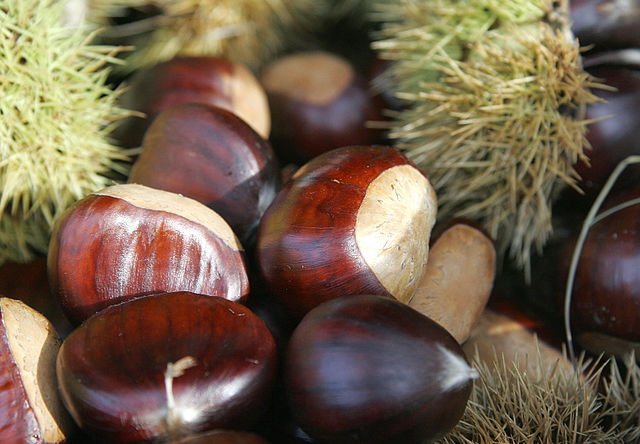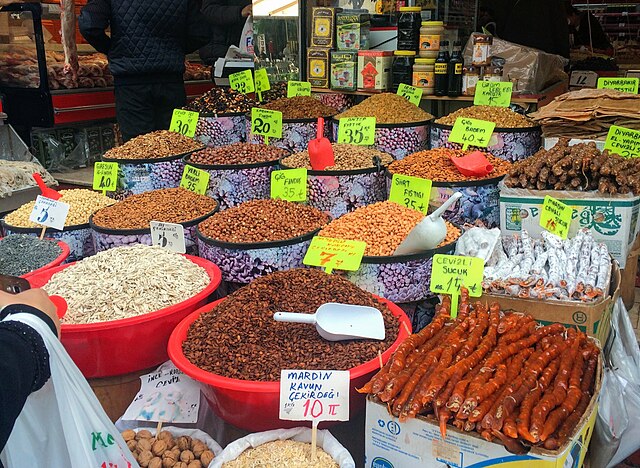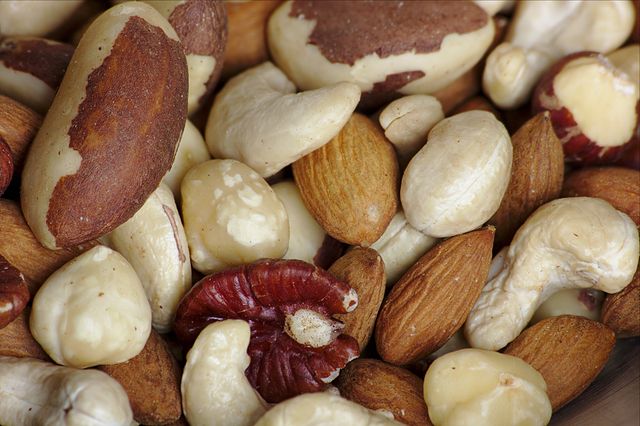Top Qs
Timeline
Chat
Perspective
Nut (food)
Foods called nuts, which may be true nuts or seeds, drupes or legumes From Wikipedia, the free encyclopedia
Remove ads
A nut is a fruit consisting of a hard or tough nutshell protecting a kernel which is usually edible. In general usage and in a culinary sense, many dry seeds are called nuts. In a botanical context, "nut" implies that the shell does not open to release the seed (indehiscent).[1]


Most seeds come from fruits that naturally free themselves from the shell, but this is not the case in nuts such as hazelnuts, chestnuts, and acorns, which have hard shell walls and originate from a compound ovary. The general and original usage of the term is less restrictive, and many nuts (in the culinary sense), such as almonds, pistachios, and Brazil nuts,[2] are not nuts in a botanical sense. Common usage of the term often refers to any hard-walled, edible kernel as a nut.[3] Nuts are an energy-dense and nutrient-rich food source.[4]
Remove ads
Definition
Summarize
Perspective
Botanically, a nut is a fruit with a woody pericarp developing from a syncarpous gynoecium. True nuts include, for example, chestnut, hazelnut and filbert. Culinarily, the term 'nut' is used much more widely, and includes examples of drupes (such as pecans and almonds) or seeds (such as pine nuts and peanuts).
Also widely known as nuts are dry drupes, which include pecans, almonds, macadamia (Macadamia integrifolia), candlenut (Aleurites moluccanus) and the water caltrop (Trapa bicornis). A drupe is an indehiscent fruit that has an outer fleshy part consisting of the exocarp, or skin, and mesocarp, or flesh, which surround a single pit or stone, the endocarp with a seed (kernel) inside. In a dry drupe, the outer parts dry up and the remaining husk is part of the ovary wall or pericarp, and the hard inner wall surrounding the seed represents the inner part of the pericarp.[5]
Walnuts and hickories (Juglandaceae) have fruits that are difficult to classify. They are considered to be nuts under some definitions but are also referred to as drupaceous nuts.[citation needed]
In common use, a "tree nut" is, as the name implies, any nut coming from a tree. This most often comes up regarding food allergies; a person may be allergic specifically to peanuts (which are not tree nuts but legumes), whereas others may be allergic to the wider range of nuts that grow on trees.
Remove ads
Production
Summarize
Perspective

In the 21st century, about a dozen species constitute most of the worldwide production of nuts, shown in the table below for major commercial nuts.[6][7]
Remove ads
Toxicity
Nuts used for food are a common source of food allergens.[4] Reactions can range from mild symptoms to severe ones, a condition known as anaphylaxis, which can be life-threatening. The reaction is due to the release of histamine by the body in response to an allergen in the nuts, causing skin and other possible reactions.[11] Many experts suggest that a person with an allergy to peanuts should avoid eating tree nuts, and vice versa.[4][12]
In the European Union, foods containing nuts must be labelled. The EU regulation[13] requires labelling of foods containing peanuts or nuts, specified as:
- almonds (Amygdalus communis L.),
- hazelnuts (Corylus avellana),
- walnuts (Juglans regia),
- cashews (Anacardium occidentale),
- pecan nuts (Carya illinoinensis (Wangenh.) K. Koch),
- Brazil nuts (Bertholletia excelsa),
- pistachio nuts (Pistacia vera),
- macadamia or Queensland nuts (Macadamia ternifolia)
and products thereof, except for nuts used for making alcoholic distillates including ethyl alcohol of agricultural origin.
Nutrition
Summarize
Perspective


Nuts contain the diverse nutrients that are needed for the growth of a new plant.[4] Composition varies, but they tend to have a low water and carbohydrate content, with high levels of fats, protein, dietary minerals, and vitamins.[4] The digestibility of the protein at about 90% is slightly lower than that of meat and fish, but can be improved by chewing thoroughly.[14] The fats are largely unsaturated and nuts are a source of essential omega-3 fatty acids.[4][15] As part of a healthy human diet, long-term consumption of diverse nutrients in nuts may contribute to a lower risk of cardiovascular diseases, reduced levels of blood cholesterol, and lower all-cause mortality.[4] For vegetarians and vegans, nuts provide many of the essential nutrients which may be in short supply in other plant foods.[14]
Nuts supply nutrients for humans and wildlife.[4] Because nuts generally have a high oil content, they are a significant energy source.[4] Many seeds are edible by humans and used in cooking, eaten raw, sprouted, or roasted as a snack food, ground to make nut butters, or pressed for oil that is used in cooking and cosmetics.[4] Regular nut consumption of more than 5 ounces (140 g) per week may benefit weight control and contribute to lowering body weight in humans.[4]
Constituents
Nuts are the source of energy and nutrients for the new plant. They contain a relatively large quantity of calories, essential unsaturated and monounsaturated fats including linoleic acid and linolenic acid, vitamins, and essential amino acids.[4] Many nuts are good sources of vitamin E, vitamin B2, folate, fiber, and essential minerals, such as magnesium, phosphorus, potassium, copper, and selenium.[4][16]
This table lists the percentage of various nutrients in four unroasted seeds.
Research
Nuts are under preliminary research to assess whether their consumption is associated with lower risk for some diseases, such as cardiovascular diseases and cancer.[4][17] A 2014 review indicated that consuming one or more servings of nuts or peanut butter per day was associated with lower risk of ischemic heart disease, overall cardiovascular disease, stroke in women, and all-cause mortality.[18] A 2022 umbrella review confirmed these findings and found a 22% reduction in all-cause mortality.[19]
Remove ads
See also
References
Further reading
External links
Wikiwand - on
Seamless Wikipedia browsing. On steroids.
Remove ads












